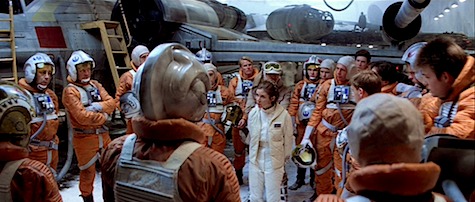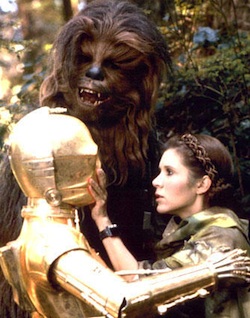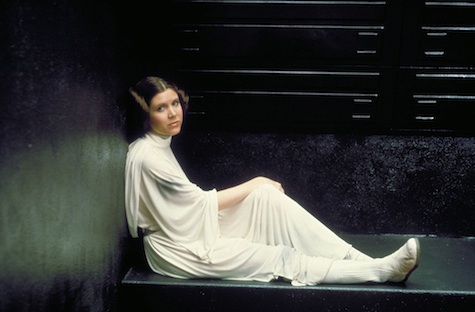When citing a slew of strong and/or important female characters in genre (or anywhere in pop culture), Princess Leia usually makes the list. It seems almost lazy, the easiest road to legitimacy because people love Star Wars, and Leia’s not perfect but without her you would’ve probably never gotten Korra or Xena or Ripley, and, you know… she’s got that doughnut hair! And carries a blaster! Right?
On the other hand, what we don’t discuss often enough is exactly why Princess Leia belongs on those lists. And she does, make no mistake — we just like to leave it at that. Maybe make a comment about how spunky she is. Or the fact that she happens to see good in everyone’s favorite smuggling rogue.
You know why we have such a hard time defining why Princess Leia is awesome? Because she was first introduced to us by her regal title: a princess.
Of course, being a princess in and of itself isn’t a problem, but George Lucas built the Star Wars trilogy on a lot of mythology. Or, more specifically, mythology as spelled out by Joseph Campbell. Whether or not that’s a good thing is entirely in the viewer’s eyes, but it did necessitate perhaps my least favorite plot trope in all of fiction: rescuing the princess. Princess Leia is cool and defiant in the face of Grand Moff Tarkin and Vader, but her planet gets blown up, and then she’s stuck in a cell being tortured for information.
Thank goodness two strapping young men and their wookiee friend show up to bust her out.
That doesn’t stop Leia from doling out one-liners faster than Han Solo can offer smart retorts, or make her any less tough in the face of powerful enemies who could simply get rid of her if she became too much of a nuisance. But unfortunately, Leia’s primary function in the first Star Wars film is to be the person who needs saving, so Luke Skywalker can have his first adventure before going to blow up a Death Star. She’s the prize, as it were.
And that can make it easy to ignore what came before and what goes after for our unsinkable Lady Organa. Leia doesn’t introduce herself to Darth Vader as a Princess of Alderaan when they first meet on the Rebel Blockade Runner, she identifies as “a member of the Imperial Senate.” She’s a politician, and an important one at that. At least, that’s all anyone in the Empire can prove at the time.
We learn, of course, that Leia is also one of the key members of the Rebel Alliance, a leading voice at the core of the insurrection. Knowing that the Empire has been in place her entire life, and that Bail Organa was fighting it from the beginning, one can easily infer that Leia’s life has been anything but balls and servants and tiara-wearing. She was raised in a household of politicians who were working to overthrow an imposed dictatorship. I doubt she had classes in curtsying, but she definitely had to be taught how to hold up under interrogation, conduct her affairs in secret, and keep her cover stories in check.

Outside the political arena, Leia still manages to be a wholly impressive figure. While her position in the Star Wars films as practically the only woman is infuriating, George Lucas still created a universe where Leia’s gender was never a reason to question her authority. In fact, Star Wars is arguably similar to how Ronald Moore’s Battlestar Galactica is constructed; there are certain problematic depictions from an audience perspective, but the fictional world that the characters occupy ultimately seems to view gender differently from ours. Notice that before the Battle of Hoth, when Leia’s instructing the pilots on their escape plan, not one of the rebels in the group want to know why they are being given their orders by a woman (who, as far we know, is not a pilot like them). She’s an effective general to them, and is afforded every respect.
Her relationship with Han is startlingly progressive for a character initially woven under a “princess” banner. Leia keeps a level head while they are captured on Cloud City, despite the fact that Han is tortured and there is a chance that she might lose him during carbon freezing. She escapes and lives, preferring to fight another day to get him back. We get to see the inverse at work with Leia; after being the one rescued at the start, she performs a rescue of her own.
And, let’s be real here, her disguise is about one hundred times more convincing than Lando’s. Until she abandons it. Erm.
In fact, it’s Han who’s shown to be short on logic when Leia gets hurt during the Battle of Endor. He’s panicking and calling for Chewie, and Leia’s the one who has to dispatch a few Storm Troopers after being shot in the arm. Aren’t women supposed to be the hysterical ones? Aren’t we supposed to fret over every little thing and absolutely fall to pieces when the men in our lives are wounded? Well, if you’re Princess Leia, you handle these drawbacks with a sardonic rejoinder, shortly before you get the job done. You’re even diplomatic enough to be able to calm down C-3PO, something that must make poor R2 incalculably envious.

Forced to be a sexual object for a crime lord? Choke him to death and get outta dodge. Find out your stealth party was spotted on by the enemy? Hunt them down with their own vehicles. Meet a strange new species that doesn’t speak your language? Share food and make friends. As we’re shown time and time again, there is nothing that this woman cannot do. She makes Luke and Han look practically incompetent if you’re actually keeping a scoreboard — Luke only has one or two solid goals that he feels obligated to follow up on, and Han spends half his time in the trilogy jamming to The Clash’s “Should I Stay or Should I Go.” You need Leia to keep it all together.
Which would be why, in the Star Wars Extended Universe novels, Leia’s eventual title is New Republic Chief of State. That’s right, she marries Han, has a few kids, then goes off to run the whole damn galaxy. Between her brilliance and Luke rebuilding the Jedi Order, it looks like Anakin Skywalker did manage to bring balance to the Force and everything else. He just didn’t do it himself.
Leia’s solidity is one of the primary reasons why Amidala doesn’t hold up in the prequels. Though there are hints that they share a similar nature, from their aptitude for politics to their willingness to get their hands dirty when the fight is on, Padme only ever comes off as a faded version of her daughter. Like Lucas took Leia, scrubbed her squeaky clean, and left her too long in the sunlight. All the vibrancy is bleached out, that key spark is missing, and the prequels are poorer for it.
So it’s not about that fantastic hair or the fact that she can fire a blaster. It’s not about how spunky she is or her lack of concern at being covered in Imperial garbage. It’s not even about how bright she was to hand over the Death Star plans to a cute little droid before things got out of hand. It’s about creative thinking, keeping it together when it counts, and outclassing every pretentious pencil pusher the Empire can throw her way.
It’s about being a leader. The leader. And while the honorary mentions and footnotes are nice, it’s far less than Princess Leia deserves.
Emmet Asher-Perrin always thought that Leia’s “politician accent” was the funniest thing. You can bug her on Twitter and read more of her work here and elsewhere.










